check engine light SKODA YETI 2011 1.G / 5L User Guide
[x] Cancel search | Manufacturer: SKODA, Model Year: 2011, Model line: YETI, Model: SKODA YETI 2011 1.G / 5LPages: 252, PDF Size: 3.61 MB
Page 88 of 252
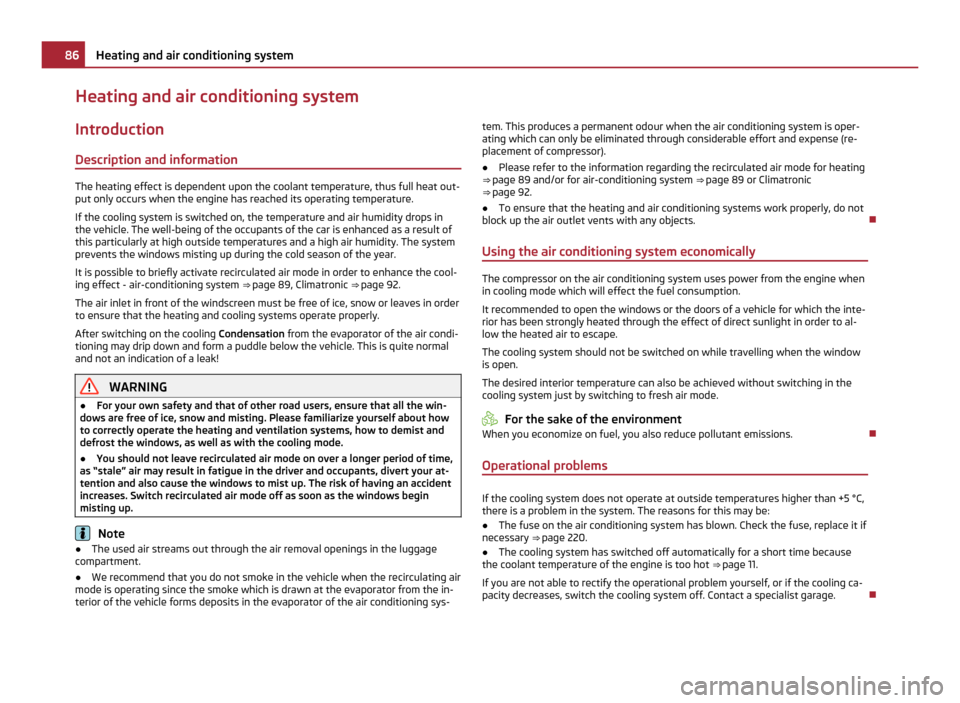
Heating and air conditioning system
Introduction
Description and information The heating effect is dependent upon the coolant temperature, thus full heat out-
put only occurs when the engine has reached its operating temperature.
If the cooling system is switched on, the temperature and air humidity drops in
the vehicle. The well-being of the occupants of the car is enhanced as a result of
this particularly at high outside temperatures and a high air humidity. The system
prevents the windows misting up during the cold season of the year.
It is possible to briefly activate recirculated air mode in order to enhance the cool-
ing effect - air-conditioning system ⇒
page 89, Climatronic ⇒ page 92.
The air inlet in front of the windscreen must be free of ice, snow or leaves in order
to ensure that the heating and cooling systems operate properly.
After switching on the cooling Condensation from the evaporator of the air condi-
tioning may drip down and form a puddle below the vehicle. This is quite normal
and not an indication of a leak! WARNING
● For your own safety and that of other road users, ensure that all the win-
dows are free of ice, snow and misting. Please familiarize yourself about how
to correctly operate the heating and ventilation systems, how to demist and
defrost the windows, as well as with the cooling mode.
● You should not leave recirculated air mode on over a longer period of time,
as
“stale” air may result in fatigue in the driver and occupants, divert your at-
tention and also cause the windows to mist up. The risk of having an accident
increases. Switch recirculated air mode off as soon as the windows begin
misting up. Note
● The used air streams out through the air removal openings in the luggage
compartment.
● We recommend that you do not smoke in the vehicle when the recirculating air
mode is operating since the smoke which is drawn at the evaporator from the in-
terior of the vehicle forms deposits in the evaporator of the air conditioning sys- tem. This produces a permanent odour when the air conditioning system is oper-
ating which can only be eliminated through considerable effort and expense (re-
placement of compressor).
● Please refer to the information regarding the recirculated air mode for heating
⇒
page 89 and/or for air-conditioning system ⇒ page 89 or Climatronic
⇒ page 92.
● To ensure that the heating and air conditioning systems work properly, do not
block up the air outlet vents with any objects.
Using the air conditioning system economically The compressor on the air conditioning system uses power from the engine when
in cooling mode which will effect the fuel consumption.
It recommended to open the windows or the doors of a vehicle for which the inte-
rior has been strongly heated through the effect of direct sunlight in order to al-
low the heated air to escape.
The cooling system should not be switched on while travelling when the window
is open.
The desired interior temperature can also be achieved without switching in the
cooling system just by switching to fresh air mode. For the sake of the environment
When you economize on fuel, you also reduce pollutant emissions.
Operational problems If the cooling system does not operate at outside temperatures higher than +5 °C,
there is a problem in the system. The reasons for this may be:
●
The fuse on the air conditioning system has blown. Check the fuse, replace it if
necessary ⇒ page 220.
● The cooling system has switched off automatically for a short time because
the coolant temperature of the engine is too hot ⇒ page 11.
If you are not able to rectify the operational problem yourself, or if the cooling ca-
pacity decreases, switch the cooling system off. Contact a specialist garage. 86
Heating and air conditioning system
Page 103 of 252
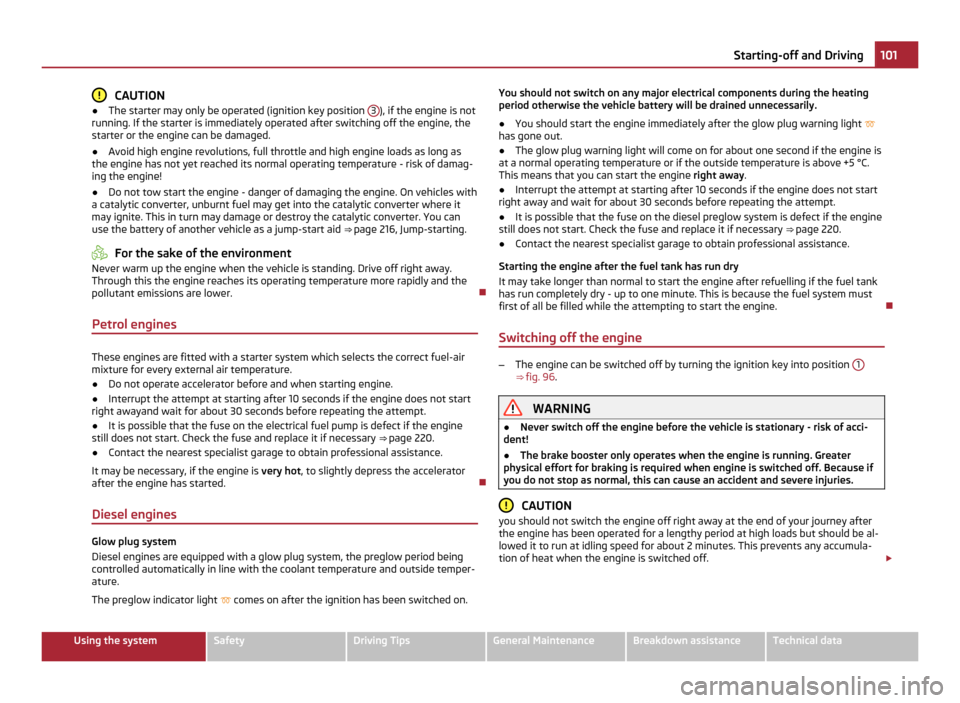
CAUTION
● The starter may only be operated (ignition key position 3 ), if the engine is not
running. If the starter is immediately operated after switching off the engine, the
starter or the engine can be damaged.
● Avoid high engine revolutions, full throttle and high engine loads as long as
the engine has not yet reached its normal operating temperature - risk of damag-
ing the engine!
● Do not tow start the engine - danger of damaging the engine. On vehicles with
a catalytic converter, unburnt fuel may get into the catalytic converter where it
may ignite. This in turn may damage or destroy the catalytic converter. You can
use the battery of another vehicle as a jump-start aid ⇒ page 216, Jump-starting
.For the sake of the environment
Never warm up the engine when the vehicle is standing. Drive off right away.
Through this the engine reaches its operating temperature more rapidly and the
pollutant emissions are lower.
Petrol engines These engines are fitted with a starter system which selects the correct fuel-air
mixture for every external air temperature.
●
Do not operate accelerator before and when starting engine.
● Interrupt the attempt at starting after 10 seconds if the engine does not start
right awayand wait for about 30 seconds before repeating the attempt.
● It is possible that the fuse on the electrical fuel pump is defect if the engine
still does not start. Check the fuse and replace it if necessary ⇒ page 220.
● Contact the nearest specialist garage to obtain professional assistance.
It may be necessary, if the engine is very hot, to slightly depress the accelerator
after the engine has started.
Diesel engines Glow plug system
Diesel engines are equipped with a glow plug system, the preglow period being
controlled automatically in line with the coolant temperature and outside temper-
ature.
The preglow indicator light comes on after the ignition has been switched on. You should not switch on any major electrical components during the heating
period otherwise the vehicle battery will be drained unnecessarily.
● You should start the engine immediately after the glow plug warning light
has gone out.
● The glow plug warning light will come on for about one second if the engine is
at a normal operating temperature or if the outside temperature is above +5 °C.
This means that you can start the engine right away.
● Interrupt the attempt at starting after 10 seconds if the engine does not start
right away and wait for about 30 seconds before repeating the attempt.
● It is possible that the fuse on the diesel preglow system is defect if the engine
still does not start. Check the fuse and replace it if necessary ⇒ page 220.
● Contact the nearest specialist garage to obtain professional assistance.
Starting the engine after the fuel tank has run dry
It may take longer than normal to start the engine after refuelling if the fuel tank
has run completely dry - up to one minute. This is because the fuel system must
first of all be filled while the attempting to start the engine.
Switching off the engine –
The engine can be switched off by turning the ignition key into position 1 ⇒
fig. 96 . WARNING
● Never switch off the engine before the vehicle is stationary - risk of acci-
dent!
● The brake booster only operates when the engine is running. Greater
physical effort for braking is required when engine is switched off. Because if
you do not stop as normal, this can cause an accident and severe injuries. CAUTION
you should not switch the engine off right away at the end of your journey after
the engine has been operated for a lengthy period at high loads but should be al-
lowed it to run at idling speed for about 2
minutes. This prevents any accumula-
tion of heat when the engine is switched off. £ 101
Starting-off and Driving Using the system Safety Driving Tips General Maintenance Breakdown assistance Technical data
Page 112 of 252
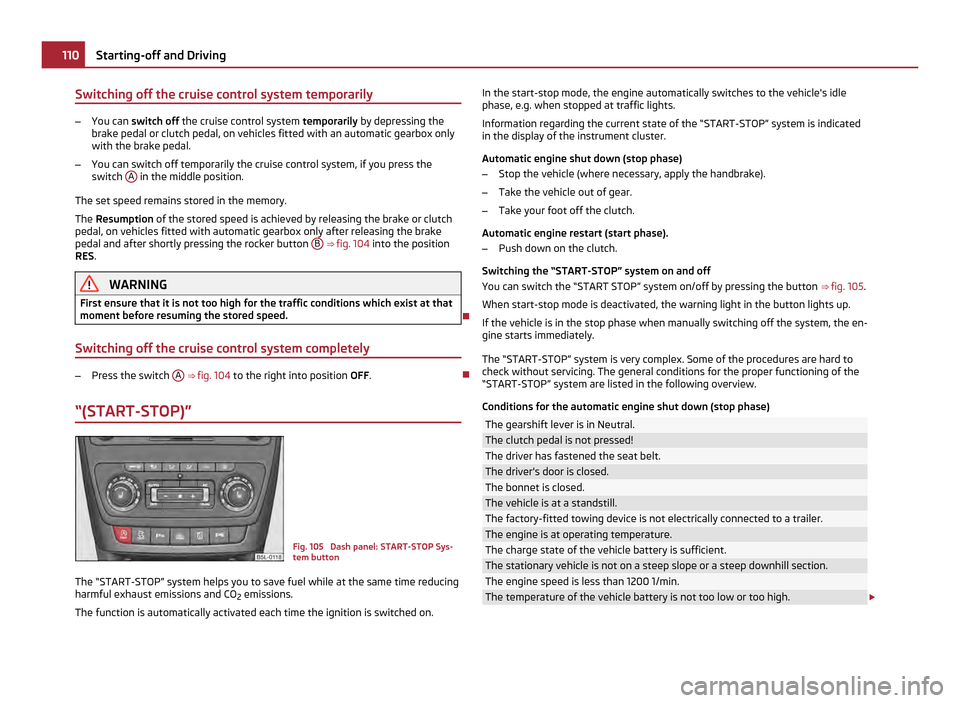
Switching off the cruise control system temporarily
–
You can switch off the cruise control system temporarily by depressing the
brake pedal or clutch pedal, on vehicles fitted with an automatic gearbox only
with the brake pedal.
– You can switch off temporarily the cruise control system, if you press the
switch A in the middle position.
The set speed remains stored in the memory.
The Resumption of the stored speed is achieved by releasing the brake or clutch
pedal, on vehicles fitted with automatic gearbox only after releasing the brake
pedal and after shortly pressing the rocker button B
⇒ fig. 104 into the position
RES. WARNING
First ensure that it is not too high for the traffic conditions which exist at that
moment before resuming the stored speed.
Switching off the cruise control system completely –
Press the switch A
⇒ fig. 104
to the right into position OFF.
“(START-STOP)” Fig. 105 Dash panel: START-STOP Sys-
tem button
The “START-STOP” system helps you to save fuel while at the same time reducing
harmful exhaust emissions and CO 2 emissions.
The function is automatically activated each time the ignition is switched on. In the start-stop mode, the engine automatically switches to the vehicle's idle
phase, e.g. when stopped at traffic lights.
Information regarding the current state of the
“START-STOP” system is indicated
in the display of the instrument cluster.
Automatic engine shut down (stop phase)
– Stop the vehicle (where necessary, apply the handbrake).
– Take the vehicle out of gear.
– Take your foot off the clutch.
Automatic engine restart (start phase).
– Push down on the clutch.
Switching the
“START-STOP” system on and off
You can switch the “START STOP” system on/off by pressing the button ⇒ fig. 105 .
When start-stop mode is deactivated, the warning light in the button lights up.
If the vehicle is in the stop phase when manually switching off the system, the en-
gine starts immediately.
The “START-STOP” system is very complex. Some of the procedures are hard to
check without servicing. The general conditions for the proper functioning of the
“START-STOP” system are listed in the following overview.
Conditions for the automatic engine shut down (stop phase) The gearshift lever is in Neutral.
The clutch pedal is not pressed!
The driver has fastened the seat belt.
The driver's door is closed.
The bonnet is closed.
The vehicle is at a standstill.
The factory-fitted towing device is not electrically connected to a trailer.
The engine is at operating temperature.
The charge state of the vehicle battery is sufficient.
The stationary vehicle is not on a steep slope or a steep downhill section.
The engine speed is less than 1200 1/min.
The temperature of the vehicle battery is not too low or too high.
£110
Starting-off and Driving
Page 161 of 252
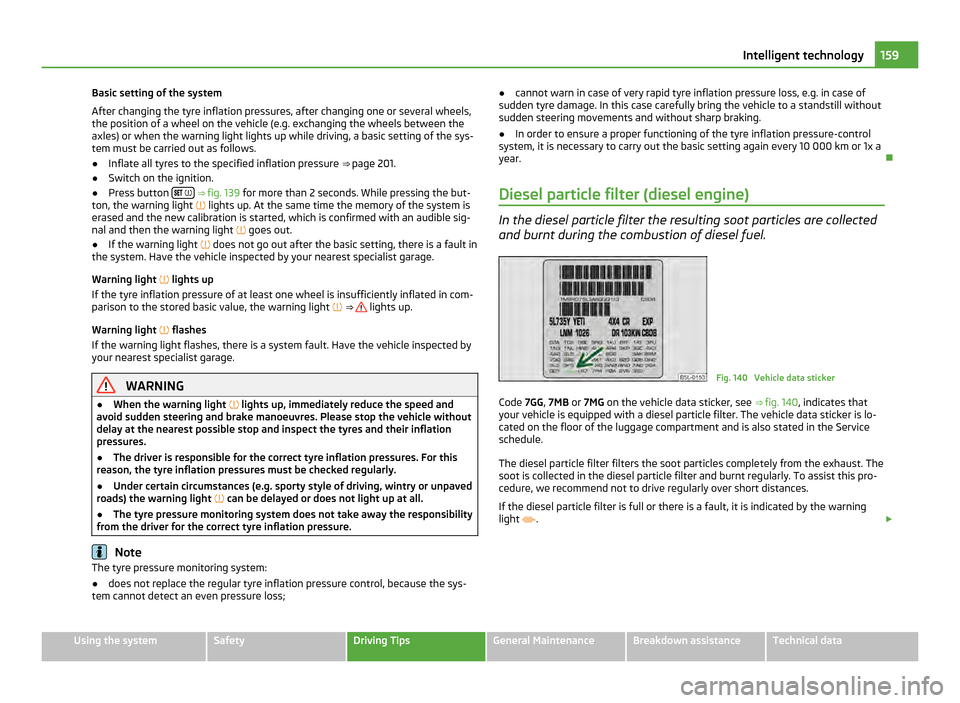
Basic setting of the system
After changing the tyre inflation pressures, after changing one or several wheels,
the position of a wheel on the vehicle (e.g. exchanging the wheels between the
axles) or when the warning light lights up while driving, a basic setting of the sys-
tem must be carried out as follows.
● Inflate all tyres to the specified inflation pressure ⇒ page 201.
● Switch on the ignition.
● Press button
⇒ fig. 139
for more than 2
seconds. While pressing the but-
ton, the warning light lights up. At the same time the memory of the system is
erased and the new calibration is started, which is confirmed with an audible sig-
nal and then the warning light goes out.
● If the warning light does not go out after the basic setting, there is a fault in
the system. Have the vehicle inspected by your nearest specialist garage.
Warning light lights up
If the tyre inflation pressure of at least one wheel is insufficiently inflated in com-
parison to the stored basic value, the warning light ⇒ lights up.
Warning light flashes
If the warning light flashes, there is a system fault. Have the vehicle inspected by
your nearest specialist garage. WARNING
● When the warning light lights up, immediately reduce the speed and
avoid sudden steering and brake manoeuvres. Please stop the vehicle without
delay at the nearest possible stop and inspect the tyres and their inflation
pressures.
● The driver is responsible for the correct tyre inflation pressures. For this
reason, the tyre inflation pressures must be checked regularly.
● Under certain circumstances (e.g. sporty style of driving, wintry or unpaved
roads) the warning light can be delayed or does not light up at all.
● The tyre pressure monitoring system does not take away the responsibility
from the driver for the correct tyre inflation pressure. Note
The tyre pressure monitoring system:
● does not replace the regular tyre inflation pressure control, because the sys-
tem cannot detect an even pressure loss; ●
cannot warn in case of very rapid tyre inflation pressure loss, e.g. in case of
sudden tyre damage. In this case carefully bring the vehicle to a standstill without
sudden steering movements and without sharp braking.
● In order to ensure a proper functioning of the tyre inflation pressure-control
system, it is necessary to carry out the basic setting again every 10 000 km or 1x a
year.
Diesel particle filter (diesel engine) In the diesel particle filter the resulting soot particles are collected
and burnt during the combustion of diesel fuel. Fig. 140 Vehicle data sticker
Code 7GG , 7MB or 7MG on the vehicle data sticker, see ⇒ fig. 140 , indicates that
your vehicle is equipped with a diesel particle filter. The vehicle data sticker is lo-
cated on the floor of the luggage compartment and is also stated in the Service
schedule.
The diesel particle filter filters the soot particles completely from the exhaust. The
soot is collected in the diesel particle filter and burnt regularly. To assist this pro-
cedure, we recommend not to drive regularly over short distances.
If the diesel particle filter is full or there is a fault, it is indicated by the warning
light . £ 159
Intelligent technology Using the system Safety Driving Tips General Maintenance Breakdown assistance Technical data
Page 173 of 252
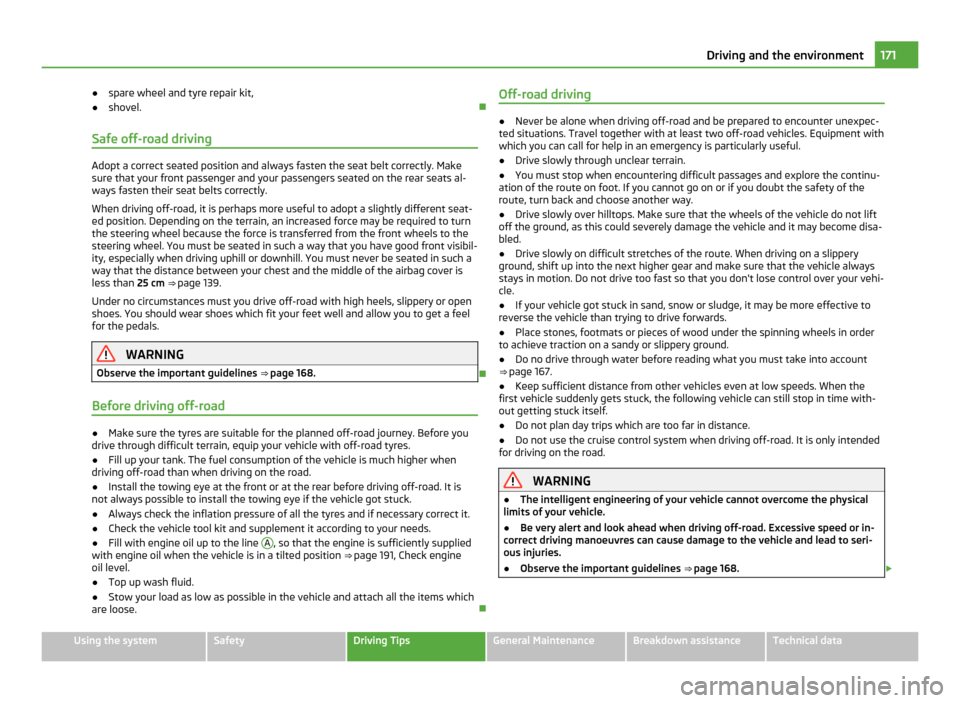
●
spare wheel and tyre repair kit,
● shovel.
Safe off-road driving Adopt a correct seated position and always fasten the seat belt correctly. Make
sure that your front passenger and your passengers seated on the rear seats al-
ways fasten their seat belts correctly.
When driving off-road, it is perhaps more useful to adopt a slightly different seat-
ed position. Depending on the terrain, an increased force may be required to turn
the steering wheel because the force is transferred from the front wheels to the
steering wheel. You must be seated in such a way that you have good front visibil-
ity, especially when driving uphill or downhill. You must never be seated in such a
way that the distance between your chest and the middle of the airbag cover is
less than 25 cm ⇒
page 139.
Under no circumstances must you drive off-road with high heels, slippery or open
shoes. You should wear shoes which fit your feet well and allow you to get a feel
for the pedals. WARNING
Observe the important guidelines ⇒
page 168.
Before driving off-road ●
Make sure the tyres are suitable for the planned off-road journey. Before you
drive through difficult terrain, equip your vehicle with off-road tyres.
● Fill up your tank. The fuel consumption of the vehicle is much higher when
driving off-road than when driving on the road.
● Install the towing eye at the front or at the rear before driving off-road. It is
not always possible to install the towing eye if the vehicle got stuck.
● Always check the inflation pressure of all the tyres and if necessary correct it.
● Check the vehicle tool kit and supplement it according to your needs.
● Fill with engine oil up to the line A , so that the engine is sufficiently supplied
with engine oil when the vehicle is in a tilted position ⇒
page 191, Check engine
oil level.
● Top up wash fluid.
● Stow your load as low as possible in the vehicle and attach all the items which
are loose. Off-road driving ●
Never be alone when driving off-road and be prepared to encounter unexpec-
ted situations. Travel together with at least two off-road vehicles. Equipment with
which you can call for help in an emergency is particularly useful.
● Drive slowly through unclear terrain.
● You must stop when encountering difficult passages and explore the continu-
ation of the route on foot. If you cannot go on or if you doubt the safety of the
route, turn back and choose another way.
● Drive slowly over hilltops. Make sure that the wheels of the vehicle do not lift
off the ground, as this could severely damage the vehicle and it may become disa-
bled.
● Drive slowly on difficult stretches of the route. When driving on a slippery
ground, shift up into the next higher gear and make sure that the vehicle always
stays in motion. Do not drive too fast so that you don't lose control over your vehi-
cle.
● If your vehicle got stuck in sand, snow or sludge, it may be more effective to
reverse the vehicle than trying to drive forwards.
● Place stones, footmats or pieces of wood under the spinning wheels in order
to achieve traction on a sandy or slippery ground.
● Do no drive through water before reading what you must take into account
⇒ page 167.
● Keep sufficient distance from other vehicles even at low speeds. When the
first vehicle suddenly gets stuck, the following vehicle can still stop in time with-
out getting stuck itself.
● Do not plan day trips which are too far in distance.
● Do not use the cruise control system when driving off-road. It is only intended
for driving on the road. WARNING
● The intelligent engineering of your vehicle cannot overcome the physical
limits of your vehicle.
● Be very alert and look ahead when driving off-road. Excessive speed or in-
correct driving manoeuvres can cause damage to the vehicle and lead to seri-
ous injuries.
● Observe the important guidelines ⇒ page 168. £ 171
Driving and the environment Using the system Safety Driving Tips General Maintenance Breakdown assistance Technical data
Page 176 of 252
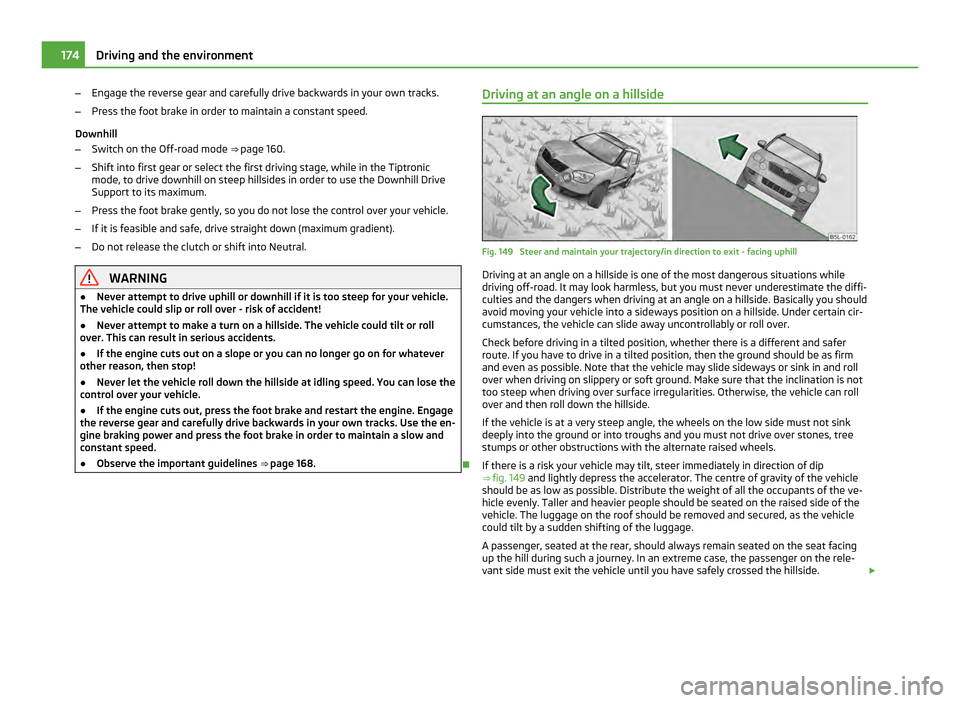
–
Engage the reverse gear and carefully drive backwards in your own tracks.
– Press the foot brake in order to maintain a constant speed.
Downhill
– Switch on the Off-road mode ⇒ page 160 .
– Shift into first gear or select the first driving stage, while in the Tiptronic
mode, to drive downhill on steep hillsides in order to use the Downhill Drive
Support to its maximum.
– Press the foot brake gently, so you do not lose the control over your vehicle.
– If it is feasible and safe, drive straight down (maximum gradient).
– Do not release the clutch or shift into Neutral. WARNING
● Never attempt to drive uphill or downhill if it is too steep for your vehicle.
The vehicle could slip or roll over - risk of accident!
● Never attempt to make a turn on a hillside. The vehicle could tilt or roll
over. This can result in serious accidents.
● If the engine cuts out on a slope or you can no longer go on for whatever
other reason, then stop!
● Never let the vehicle roll down the hillside at idling speed. You can lose the
control over your vehicle.
● If the engine cuts out, press the foot brake and restart the engine. Engage
the reverse gear and carefully drive backwards in your own tracks. Use the en-
gine braking power and press the foot brake in order to maintain a slow and
constant speed.
● Observe the important guidelines ⇒ page 168. Driving at an angle on a hillside Fig. 149 Steer and maintain your trajectory/in direction to exit - facing uphill
Driving at an angle on a hillside is one of the most dangerous situations while
driving off-road. It may look harmless, but you must never underestimate the diffi-
culties and the dangers when driving at an angle on a hillside. Basically you should
avoid moving your vehicle into a sideways position on a hillside. Under certain cir-
cumstances, the vehicle can slide away uncontrollably or roll over.
Check before driving in a tilted position, whether there is a different and safer
route. If you have to drive in a tilted position, then the ground should be as firm
and even as possible. Note that the vehicle may slide sideways or sink in and roll
over when driving on slippery or soft ground. Make sure that the inclination is not
too steep when driving over surface irregularities. Otherwise, the vehicle can roll
over and then roll down the hillside.
If the vehicle is at a very steep angle, the wheels on the low side must not sink
deeply into the ground or into troughs and you must not drive over stones, tree
stumps or other obstructions with the alternate raised wheels.
If there is a risk your vehicle may tilt, steer immediately in direction of dip
⇒ fig. 149 and lightly depress the accelerator. The centre of gravity of the vehicle
should be as low as possible. Distribute the weight of all the occupants of the ve-
hicle evenly. Taller and heavier people should be seated on the raised side of the
vehicle. The luggage on the roof should be removed and secured, as the vehicle
could tilt by a sudden shifting of the luggage.
A passenger, seated at the rear, should always remain seated on the seat facing
up the hill during such a journey. In an extreme case, the passenger on the rele-
vant side must exit the vehicle until you have safely crossed the hillside. £174
Driving and the environment
Page 178 of 252
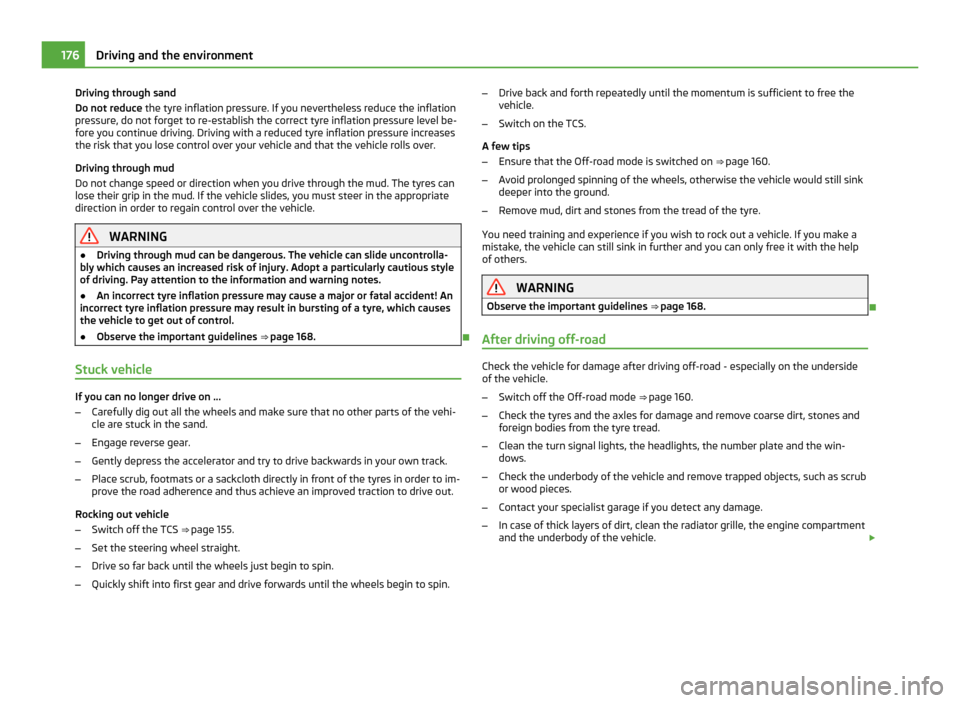
Driving through sand
Do not reduce
the tyre inflation pressure. If you nevertheless reduce the inflation
pressure, do not forget to re-establish the correct tyre inflation pressure level be-
fore you continue driving. Driving with a reduced tyre inflation pressure increases
the risk that you lose control over your vehicle and that the vehicle rolls over.
Driving through mud
Do not change speed or direction when you drive through the mud. The tyres can
lose their grip in the mud. If the vehicle slides, you must steer in the appropriate
direction in order to regain control over the vehicle. WARNING
● Driving through mud can be dangerous. The vehicle can slide uncontrolla-
bly which causes an increased risk of injury. Adopt a particularly cautious style
of driving. Pay attention to the information and warning notes.
● An incorrect tyre inflation pressure may cause a major or fatal accident! An
incorrect tyre inflation pressure may result in bursting of a tyre, which causes
the vehicle to get out of control.
● Observe the important guidelines ⇒ page 168.
Stuck vehicle If you can no longer drive on ...
–
Carefully dig out all the wheels and make sure that no other parts of the vehi-
cle are stuck in the sand.
– Engage reverse gear.
– Gently depress the accelerator and try to drive backwards in your own track.
– Place scrub, footmats or a sackcloth directly in front of the tyres in order to im-
prove the road adherence and thus achieve an improved traction to drive out.
Rocking out vehicle
– Switch off the TCS ⇒ page 155.
– Set the steering wheel straight.
– Drive so far back until the wheels just begin to spin.
– Quickly shift into first gear and drive forwards until the wheels begin to spin. –
Drive back and forth repeatedly until the momentum is sufficient to free the
vehicle.
– Switch on the TCS.
A few tips
– Ensure that the Off-road mode is switched on ⇒ page 160.
– Avoid prolonged spinning of the wheels, otherwise the vehicle would still sink
deeper into the ground.
– Remove mud, dirt and stones from the tread of the tyre.
You need training and experience if you wish to rock out a vehicle. If you make a
mistake, the vehicle can still sink in further and you can only free it with the help
of others. WARNING
Observe the important guidelines ⇒
page 168.
After driving off-road Check the vehicle for damage after driving off-road - especially on the underside
of the vehicle.
–
Switch off the Off-road mode
⇒
page 160.
– Check the tyres and the axles for damage and remove coarse dirt, stones and
foreign bodies from the tyre tread.
– Clean the turn signal lights, the headlights, the number plate and the win-
dows.
– Check the underbody of the vehicle and remove trapped objects, such as scrub
or wood pieces.
– Contact your specialist garage if you detect any damage.
– In case of thick layers of dirt, clean the radiator grille, the engine compartment
and the underbody of the vehicle. £176
Driving and the environment
Page 180 of 252
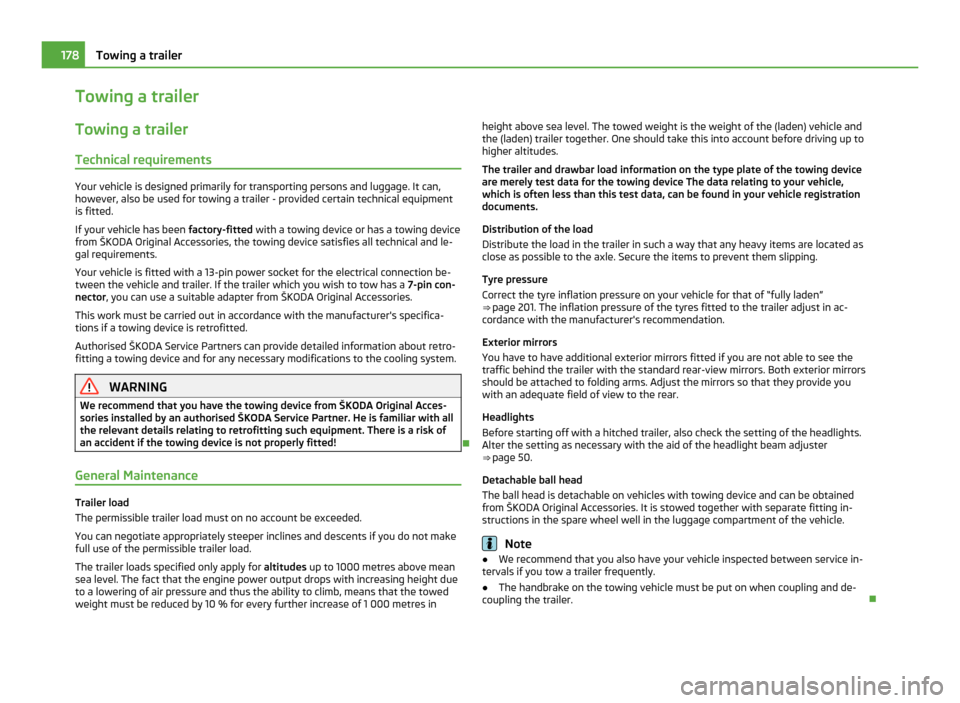
Towing a trailer
Towing a trailer
Technical requirements Your vehicle is designed primarily for transporting persons and luggage. It can,
however, also be used for towing a trailer - provided certain technical equipment
is fitted.
If your vehicle has been
factory-fitted with a towing device or has a towing device
from
ŠKODA Original Accessories, the towing device satisfies all technical and le-
gal requirements.
Your vehicle is fitted with a 13-pin power socket for the electrical connection be-
tween the vehicle and trailer. If the trailer which you wish to tow has a 7-pin con-
nector , you can use a suitable adapter from ŠKODA Original Accessories.
This work must be carried out in accordance with the manufacturer's specifica-
tions if a towing device is retrofitted.
Authorised ŠKODA Service Partners can provide detailed information about retro-
fitting a towing device and for any necessary modifications to the cooling system. WARNING
We recommend that you have the towing device from ŠKODA Original Acces-
sories installed by an authorised
ŠKODA Service Partner. He is familiar with all
the relevant details relating to retrofitting such equipment. There is a risk of
an accident if the towing device is not properly fitted!
General Maintenance Trailer load
The permissible trailer load must on no account be exceeded.
You can negotiate appropriately steeper inclines and descents if you do not make
full use of the permissible trailer load.
The trailer loads specified only apply for
altitudes up to 1000 metres above mean
sea level. The fact that the engine power output drops with increasing height due
to a lowering of air pressure and thus the ability to climb, means that the towed
weight must be reduced by 10 % for every further increase of 1 000 metres in height above sea level. The towed weight is the weight of the (laden) vehicle and
the (laden) trailer together. One should take this into account before driving up to
higher altitudes.
The trailer and drawbar load information on the type plate of the towing device
are merely test data for the towing device The data relating to your vehicle,
which is often less than this test data, can be found in your vehicle registration
documents.
Distribution of the load
Distribute the load in the trailer in such a way that any heavy items are located as
close as possible to the axle. Secure the items to prevent them slipping.
Tyre pressure
Correct the tyre inflation pressure on your vehicle for that of
“fully laden”
⇒ page 201. The inflation pressure of the tyres fitted to the trailer adjust in ac-
cordance with the manufacturer's recommendation.
Exterior mirrors
You have to have additional exterior mirrors fitted if you are not able to see the
traffic behind the trailer with the standard rear-view mirrors. Both exterior mirrors
should be attached to folding arms. Adjust the mirrors so that they provide you
with an adequate field of view to the rear.
Headlights
Before starting off with a hitched trailer, also check the setting of the headlights.
Alter the setting as necessary with the aid of the headlight beam adjuster
⇒ page 50.
Detachable ball head
The ball head is detachable on vehicles with towing device and can be obtained
from ŠKODA Original Accessories. It is stowed together with separate fitting in-
structions in the spare wheel well in the luggage compartment of the vehicle. Note
● We recommend that you also have your vehicle inspected between service in-
tervals if you tow a trailer frequently.
● The handbrake on the towing vehicle must be put on when coupling and de-
coupling the trailer. 178
Towing a trailer
Page 181 of 252
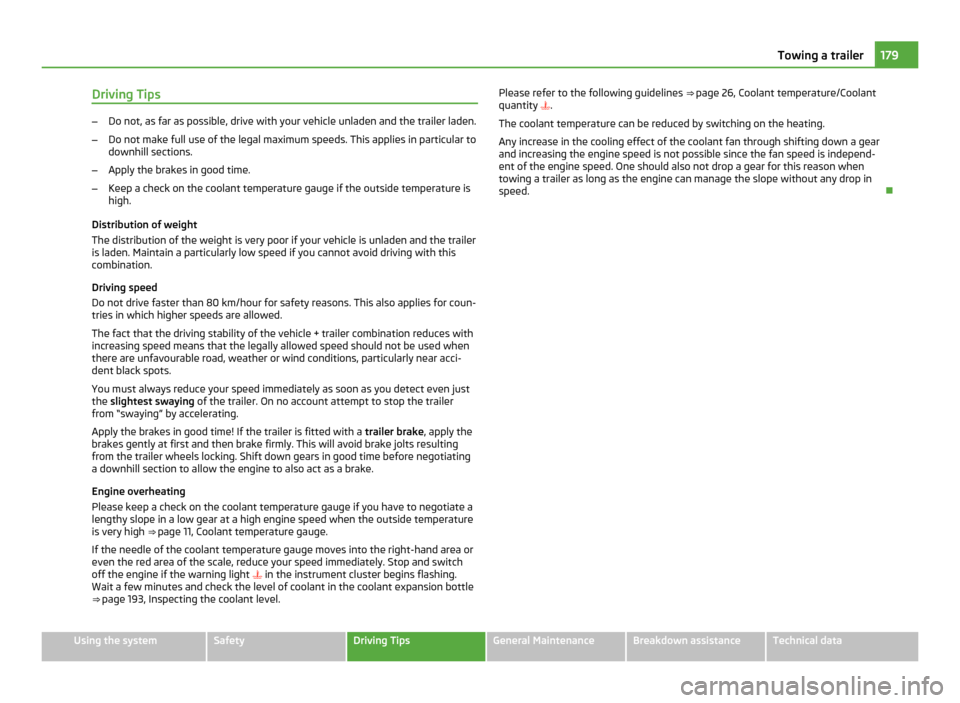
Driving Tips
–
Do not, as far as possible, drive with your vehicle unladen and the trailer laden.
– Do not make full use of the legal maximum speeds. This applies in particular to
downhill sections.
– Apply the brakes in good time.
– Keep a check on the coolant temperature gauge if the outside temperature is
high.
Distribution of weight
The distribution of the weight is very poor if your vehicle is unladen and the trailer
is laden. Maintain a particularly low speed if you cannot avoid driving with this
combination.
Driving speed
Do not drive faster than 80 km/hour for safety reasons. This also applies for coun-
tries in which higher speeds are allowed.
The fact that the driving stability of the vehicle + trailer combination reduces with
increasing speed means that the legally allowed speed should not be used when
there are unfavourable road, weather or wind conditions, particularly near acci-
dent black spots.
You must always reduce your speed immediately as soon as you detect even just
the slightest swaying of the trailer. On no account attempt to stop the trailer
from “swaying” by accelerating.
Apply the brakes in good time! If the trailer is fitted with a trailer brake, apply the
brakes gently at first and then brake firmly. This will avoid brake jolts resulting
from the trailer wheels locking. Shift down gears in good time before negotiating
a downhill section to allow the engine to also act as a brake.
Engine overheating
Please keep a check on the coolant temperature gauge if you have to negotiate a
lengthy slope in a low gear at a high engine speed when the outside temperature
is very high ⇒ page 11, Coolant temperature gauge
.
If the needle of the coolant temperature gauge moves into the right-hand area or
even the red area of the scale, reduce your speed immediately. Stop and switch
off the engine if the warning light in the instrument cluster begins flashing.
Wait a few minutes and check the level of coolant in the coolant expansion bottle
⇒ page 193, Inspecting the coolant level. Please refer to the following guidelines
⇒
page 26, Coolant temperature/Coolant
quantity .
The coolant temperature can be reduced by switching on the heating.
Any increase in the cooling effect of the coolant fan through shifting down a gear
and increasing the engine speed is not possible since the fan speed is independ-
ent of the engine speed. One should also not drop a gear for this reason when
towing a trailer as long as the engine can manage the slope without any drop in
speed. 179
Towing a trailer Using the system Safety Driving Tips General Maintenance Breakdown assistance Technical data
Page 191 of 252
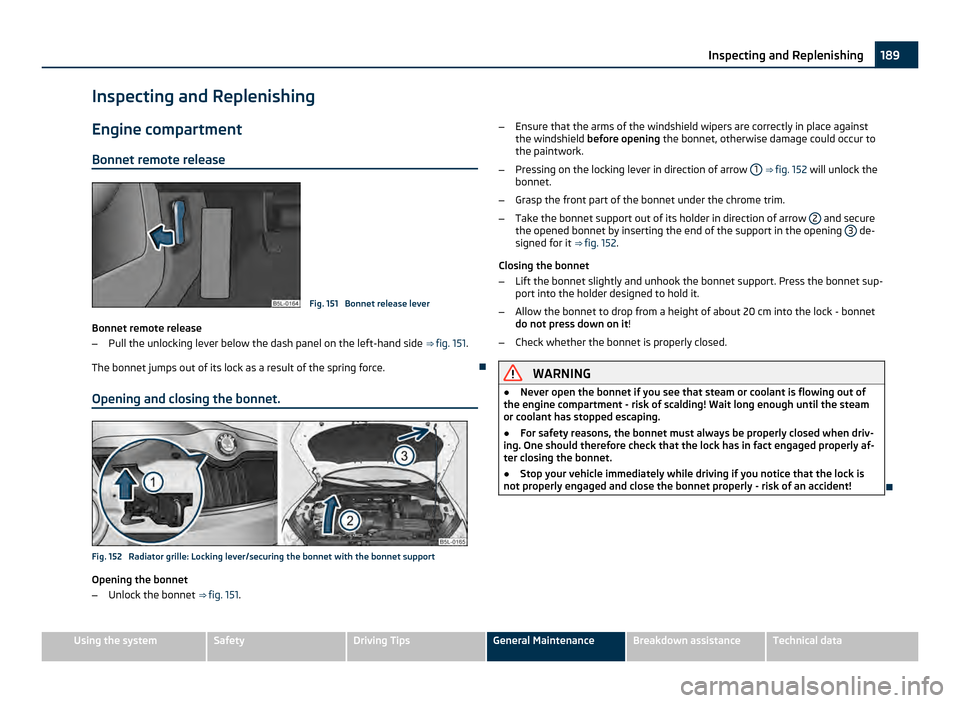
Inspecting and Replenishing
Engine compartment
Bonnet remote release Fig. 151 Bonnet release lever
Bonnet remote release
– Pull the unlocking lever below the dash panel on the left-hand side ⇒ fig. 151.
The bonnet jumps out of its lock as a result of the spring force.
Opening and closing the bonnet. Fig. 152 Radiator grille: Locking lever/securing the bonnet with the bonnet support
Opening the bonnet
–
Unlock the bonnet ⇒
fig. 151. –
Ensure that the arms of the windshield wipers are correctly in place against
the windshield before opening the bonnet, otherwise damage could occur to
the paintwork.
– Pressing on the locking lever in direction of arrow 1 ⇒
fig. 152 will unlock the
bonnet.
– Grasp the front part of the bonnet under the chrome trim.
– Take the bonnet support out of its holder in direction of arrow 2 and secure
the opened bonnet by inserting the end of the support in the opening 3 de-
signed for it ⇒ fig. 152.
Closing the bonnet
– Lift the bonnet slightly and unhook the bonnet support. Press the bonnet sup-
port into the holder designed to hold it.
– Allow the bonnet to drop from a height of about 20 cm into the lock - bonnet
do not press down on it!
– Check whether the bonnet is properly closed. WARNING
● Never open the bonnet if you see that steam or coolant is flowing out of
the engine compartment - risk of scalding! Wait long enough until the steam
or coolant has stopped escaping.
● For safety reasons, the bonnet must always be properly closed when driv-
ing. One should therefore check that the lock has in fact engaged properly af-
ter closing the bonnet.
● Stop your vehicle immediately while driving if you notice that the lock is
not properly engaged and close the bonnet properly - risk of an accident! 189
Inspecting and Replenishing Using the system Safety Driving Tips General Maintenance Breakdown assistance Technical data